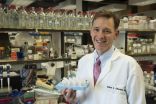(Press-News.org) A breast cancer vaccine developed at Washington University School of Medicine in St. Louis is safe in patients with metastatic breast cancer, results of an early clinical trial indicate. Preliminary evidence also suggests that the vaccine primed the patients' immune systems to attack tumor cells and helped slow the cancer's progression.
The study appears Dec. 1 in Clinical Cancer Research.
The new vaccine causes the body's immune system to home in on a protein called mammaglobin-A, found almost exclusively in breast tissue. The protein's role in healthy tissue is unclear, but breast tumors express it at abnormally high levels, past research has shown.
"Being able to target mammaglobin is exciting because it is expressed broadly in up to 80 percent of breast cancers, but not at meaningful levels in other tissues," said breast cancer surgeon and senior author William E. Gillanders, MD, professor of surgery. "In theory, this means we could treat a large number of breast cancer patients with potentially fewer side effects.
"It's also exciting to see this work progress from identifying the importance of mammaglobin-A, to designing a therapeutic agent, manufacturing it and giving it to patients, all by investigators at Washington University," he added.
The vaccine primes a type of white blood cell, part of the body's adaptive immune system, to seek out and destroy cells with the mammaglobin-A protein. In the smaller proportion of breast cancer patients whose tumors do not produce mammaglobin-A, this vaccine would not be effective.
In the new study, 14 patients with metastatic breast cancer that expressed mammaglobin-A were vaccinated. The Phase 1 trial was designed mainly to assess the vaccine's safety. According to the authors, patients experienced few side effects, reporting eight events classified as mild or moderate, including rash, tenderness at the vaccination site and mild flu-like symptoms. No severe or life-threatening side effects occurred.
Although the trial was designed to test vaccine safety, preliminary evidence indicated the vaccine slowed the cancer's progression, even in patients who tend to have less potent immune systems because of their advanced disease and exposure to chemotherapy.
"Despite the weakened immune systems in these patients, we did observe a biologic response to the vaccine while analyzing immune cells in their blood samples," said Gillanders, who treats patients at Siteman Cancer Center at Barnes-Jewish Hospital and Washington University. "That's very encouraging. We also saw preliminary evidence of improved outcome, with modestly longer progression-free survival."
Of the 14 patients who received the vaccine, about half showed no progression of their cancer one year after receiving the vaccine. In a similar control group of 12 patients who were not vaccinated, about one-fifth showed no cancer progression at the one-year follow-up. Despite the small sample size, this difference is statistically significant.
Based on results of this study, Gillanders and his colleagues are planning a larger clinical trial to test the vaccine in newly diagnosed breast cancer patients, who, in theory, should have more robust immune systems than patients who already have undergone extensive cancer therapy.
"If we give the vaccine to patients at the beginning of treatment, the immune systems should not be compromised like in patients with metastatic disease," Gillanders said. "We also will be able to do more informative immune monitoring than we did in this preliminary trial. Now that we have good evidence that the vaccine is safe, we think testing it in newly diagnosed patients will give us a better idea of the effectiveness of the therapy."
INFORMATION:
This work was supported by the Breast Cancer Research Program (BCRP) of the Department of Defense Congressionally Directed Medical Research Programs (DOD/CDMRP), grant number W81XWH-61-0677; Gateway for Cancer Research, P-06-016; The Foundation for Barnes-Jewish Hospital; the National Cancer Institute (NCI) of the National Institutes of Health (NIH), T32 CA009621; the NCI Cancer Center Support Grant, P30 CA91842; and George and Diana Holway.
Tiriveedhi V, Tucker N, Herndon J, Li L, Sturmoski M, Ellis M, Ma C, Naughton M, Lockhart AC, Gao F, Fleming T, Goedegebuure P, Mohanakumar T, Gillanders WE. Safety and preliminary evidence of biological efficacy of a mammaglobin-A DNA vaccine in patients with stable metastatic breast cancer. Clinical Cancer Research. Dec. 1, 2014.
Washington University School of Medicine's 2,100 employed and volunteer faculty physicians also are the medical staff of Barnes-Jewish and St. Louis Children's hospitals. The School of Medicine is one of the leading medical research, teaching and patient-care institutions in the nation, currently ranked sixth in the nation by U.S. News & World Report. Through its affiliations with Barnes-Jewish and St. Louis Children's hospitals, the School of Medicine is linked to BJC HealthCare.
URL: https://news.wustl.edu/news/Pages/27732.aspx
Nearly 55 percent of U.S. infants are placed to sleep with bedding that increases the risk of sudden infant death syndrome, or SIDS, despite recommendations against the practice, report researchers at the National Institutes of Health, the Centers for Disease Control and Prevention, and other institutions.
Soft objects and loose bedding--such as thick blankets, quilts, and pillows--can obstruct an infant's airway and pose a suffocation risk, according to the NIH's Safe to Sleep campaign. Soft bedding has also been shown to increase the risk of SIDS Infants should be ...
UNIVERSITY OF CALIFORNIA, BERKELEY'S HAAS SCHOOL OF BUSINESS -People may associate political correctness with conformity but new research finds it also correlates with creativity in work settings. Imposing a norm that sets clear expectations of how women and men should interact with each other into a work environment unexpectedly encourages creativity among mixed-sex work groups by reducing uncertainty in relationships.
The study highlights a paradoxical consequence of the political correctness (PC) norm. While PC behavior is generally thought to threaten the free expression ...
Behavioural and drug interventions aiming to prevent people with prediabetes progressing to full blown type 2 diabetes are equally effective for both sexes at preventing progression and reducing weight, according to a new systematic review and meta-analysis. The research is by Dr Anna Glechner, Danube University Krems, Austria, and Dr Jürgen Harreiter, Medical University of Vienna, Austria, and colleagues.
Prediabetes is a general term that refers to an intermediate stage between normal blood glucose control (normoglycaemia) and type 2 diabetes (high blood glucose ...
Using a patient's own rib cartilage (autologous) for rhinoplasty appears to be associated with low rates of overall long-term complications and problems at the rib site where the cartilage is removed, according to a report published online by JAMA Facial Plastic Surgery.
Autologous rib cartilage is the preferred source of graft material for rhinoplasty because of its strength and ample volume. However, using rib cartilage for dorsal augmentation to build up the bridge of the nose has been criticized for its tendency to warp and issues at the cartilage donor site, such ...
The five-year survival rate for advanced-stage laryngeal cancer was higher than national levels in a small study at a single academic center performing a high rate of surgical therapy, including a total laryngectomy (removal of the voice box), to treat the disease, despite a national trend toward organ preservation, according to a report published online by JAMA Otolaryngology-Head & Neck Surgery.
The larynx is a common site of head and neck cancer with more than 10,000 cases annually. Over the past two decades, treatment for advanced-stage laryngeal cancer has shifted ...
The way that tetanus neurotoxin enters nerve cells has been discovered by UCL scientists, who showed that this process can be blocked, offering a potential therapeutic intervention for tetanus. This newly-discovered pathway could be exploited to deliver therapies to the nervous system, opening up a whole new way to treat neurological disorders such as motor neuron disease and peripheral neuropathies.
The research in mice, published in Science and funded by the Medical Research Council, shows that proteins called nidogens that coat cell surfaces are key to tetanus neurotoxin ...
PITTSBURGH--The rise of social media has seemed like a bonanza for behavioral scientists, who have eagerly tapped the social nets to quickly and cheaply gather huge amounts of data about what people are thinking and doing. But computer scientists at Carnegie Mellon University and McGill University warn that those massive datasets may be misleading.
In a perspective article published in the Nov. 28 issue of the journal Science, Carnegie Mellon's Juergen Pfeffer and McGill's Derek Ruths contend that scientists need to find ways of correcting for the biases inherent in the ...
Walter and Eliza Hall Institute researchers have defined for the first time how the size of the immune response is controlled, using mathematical models to predict how powerfully immune cells respond to infection and disease.
The finding, published today in the journal Science, has implications for our understanding of how harmful or beneficial immune responses can be manipulated for better health.
The research team used mathematics and computer modeling to understand how complex signaling impacts the size of the response by key infection-fighting immune cells called ...
Given that some climate change is already unavoidable--as just confirmed by the new IPCC report--investing in empowerment through universal education should be an essential element in climate change adaptation efforts, which so far focus mostly in engineering projects, according to a new study from the International Institute for Applied Systems Analysis (IIASA) published in the journal Science.
The article draws upon extensive analysis of natural disaster data for 167 countries over the past four decades as well as a number of studies carried out in individual countries ...
Nora Besansky, O'Hara Professor of Biological Sciences at the University of Notre Dame and a member of the University's Eck Institute for Global Health, has led an international team of scientists in sequencing the genomes of 16 Anopheles mosquito species from around the world.
Anopheles mosquitoes are responsible for transmitting human malaria parasites that cause an estimated 200 million cases and more than 600 thousand deaths each year. However, of the almost 500 different Anopheles species, only a few dozen can carry the parasite and only a handful of species are responsible ...



